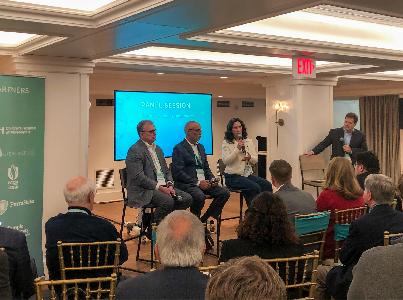From the outside, it’s just another hulking Philadelphia warehouse.
This one, which straddles the border between Kensington and Port Richmond, doesn’t look abandoned. But there were few signs of life outside what its new owners are calling “The Loom at Richmond Mills” — very little to suggest the dozens of artisans and manufacturers inside the bustling shared workspace.
With its 80 tenants in the 250,000 sq.ft. space at roughly Frankford and Allegheny Avenues, The Loom hosts “the largest collection of artisans in the city,” said The Loom’s Director of Partnership and Special Projects Martin Montero.
Below, take a peek at some workspaces inside The Loom. Due to the building’s scale, the availability of tenants and the desire of some businesses to remain private, this is in no way an exhaustive photo tour.

Elm City Capital, the new owners of the building, painted the walls with these directions because the building is so huge and sprawling.
Tenants range from those that have been there for decades (the building was 50 percent occupied when Loom owner Chris Dardaris and his former business partner purchased it in 2006, Montero said), like a book binder and a stovetop cover manufacturer, to newer, more boutique tenants like Rival Brothers Coffee, which roasts its coffee beans at The Loom, and printshop Fireball Printing.

The Ceramic Shop, a pottery supply manufacturer and retailer, has a storefront on the first floor of The Loom.
The Loom’s management wants to cultivate a community inside the building, which can be more difficult than doing so in a smaller, more conventional coworking space, since each Loom tenant has its own private workspace.
That’s part of the reason the owners plan to open a cafe inside the building, Montero said: to offer a common space for its tenants.

The Ceramic Shop makes and sells pottery supplies. Its customers often come from out of state, said founder Mark Lueders (not pictured), because pottery supply stores are few and far between.
The space is currently at 95 percent capacity, Montero said, but once some of the older companies’ leases are up, management will think more strategically about who it wants as members of The Loom.
“Not everyone fits the culture,” he said.
On the one day Technically Philly visited, there was a noticeable difference between the longtime tenants and the new ones. For one, there was a difference in how a reporter’s presence was received. Most of the tenants that had been there for decades, with the exception of the Ceramic Shop and bookbinders Allen L. Geiser and Son, made it clear they wanted to keep to themselves. Of course, this was just one experience we had with the handful of tenants that were available that day.
It was not unlike Frankford’s Globe Dye Works, an enormous campus of industrial buildings that in the last four years has been transitioning from closed factory to cultural hub. There seems to be a different sense of community in sprawling industrial buildings and so a different sense of privacy.
The Loom’s owners have a socially-minded goal, too, they say. They hope to train community members in various trades to play a part in what Montero calls “the renaissance of American manufacturing.” Loom management has already purchased a shuttered, nearby school building and hopes to turn it into a vocational school, Montero said. Because of it’s rich industrial history, Montero said Loom management believes “there’s still some of that skill left here.” It just needs to be nurtured.

We used old-school elevators to get around The Loom. On the left, Martin Montero, The Loom’s Director of Partnerships and Special Projects.

The entrance to Sire Press, which does CD & DVD duplication, next to one of book binder Allen L. Geiser and Son‘s many machines.

Inside book binder Allen L. Geiser and Son‘s workspace.

The fifth floor of The Loom South will be occupied by Art/Assembly, an artists’ co-op that opened in November.
For more on The Loom, check out this Flying Kite feature.
Photos by Aidan Un
Join the conversation!
Find news, events, jobs and people who share your interests on Technical.ly's open community Slack

Philly daily roundup: Earth Day glossary; Gen AI's energy cost; Biotech incubator in Horsham

Philly daily roundup: Women's health startup wins pitch; $204M for internet access; 'GamingWalls' for sports venues

Philly daily roundup: East Market coworking; Temple's $2.5M engineering donation; WITS spring summit






